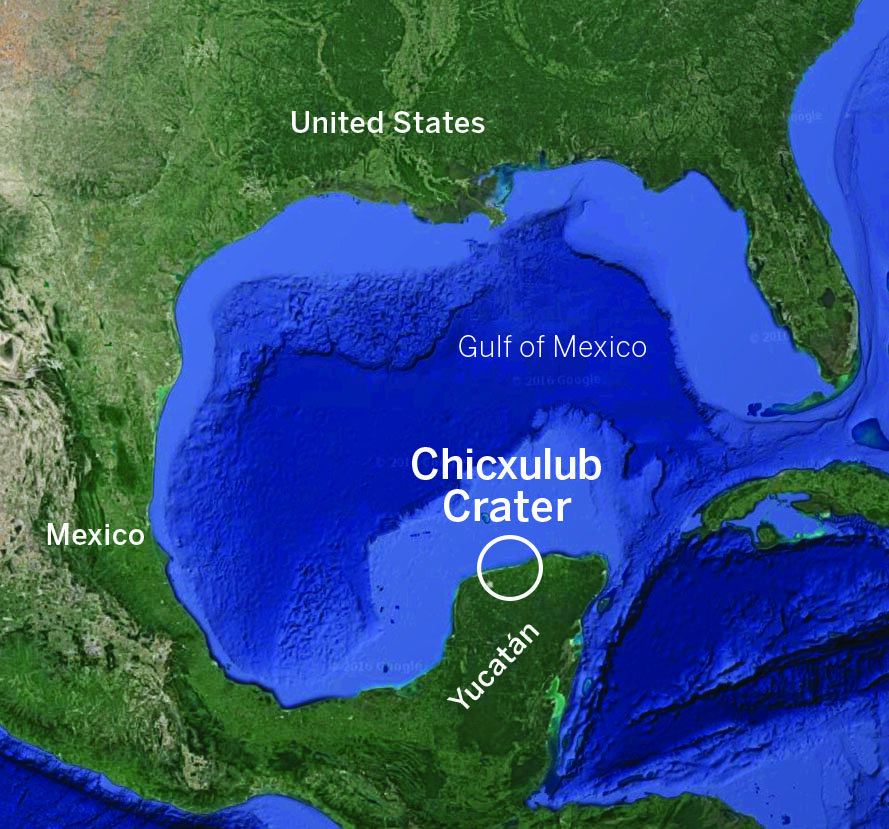The death of an asteroid, not from a series of volcanic eruptions or any other global disaster, was
 The crater left by the asteroid that wiped out the dinosaurs is located on the Yucatan Peninsula and is called Chicxulub after a nearby city.Part of the crater is on the sea, and part is on land.A 2016 mission led by the International Ocean Discovery Program recovered rock cores from the crater's coastal portion.Credit: University of Texas at Austin / Jackson School of Geosciences / Google Maps
The crater left by the asteroid that wiped out the dinosaurs is located on the Yucatan Peninsula and is called Chicxulub after a nearby city.Part of the crater is on the sea, and part is on land.A 2016 mission led by the International Ocean Discovery Program recovered rock cores from the crater's coastal portion.Credit: University of Texas at Austin / Jackson School of Geosciences / Google Maps
This is the latest study conducted as part of the 2016 mission of the International Ocean Research Program.In the course of it, more than 900 meters of a rock core were collected from a crater buried under the seabed.Research into this mission has helped fill in the gaps regarding impacts, impacts, and the recovery of life after an asteroid impact.
The main sign of asteroid dust is the elementiridium, which is rare in the earth's crust. Moreover, it is quite abundant in some types of asteroids. In a new study, scientists found a trace of iridium in a piece of rock excavated from the crater. In the crater, a layer of sediment deposited for days or years after the impact is so thick that scientists were able to pinpoint the age of the dust just two decades after the impact.
 Part of the core of the rock, torn out of the crater,left by an asteroid impact that destroyed the dinosaurs. Researchers have found high concentrations of the element iridium - a marker of asteroid material - in the middle of the core, which contains a mixture of impact ash and ocean sediment deposited over decades. Iridium is measured in parts per billion.
Part of the core of the rock, torn out of the crater,left by an asteroid impact that destroyed the dinosaurs. Researchers have found high concentrations of the element iridium - a marker of asteroid material - in the middle of the core, which contains a mixture of impact ash and ocean sediment deposited over decades. Iridium is measured in parts per billion.
Dust is all that remains of an 11 km wide asteroid that crashed into the planet millions of years ago, causing the extinction of 75% of life on Earth, including all non-Avian dinosaurs.
The researchers estimate that the dust lifted by the impact has been circulating in the atmosphere for no more than a couple of decades. This helps determine how long the extinction lasted.
Highest concentrations of iridium foundin a 5-centimeter section of the rock core excavated from the top of the crater's peak ring - a high point in the crater that formed when rocks bounced off and then collapsed from the force of the impact.
Iridium analysis was carried out in laboratories in Austria, Belgium, Japan and the USA.
Read also
Physicists have created an analogue of a black hole and confirmed Hawking's theory. Where it leads?
Abortion and science: what will happen to the children who will give birth
Scientists have discovered the speed limit in the quantum world